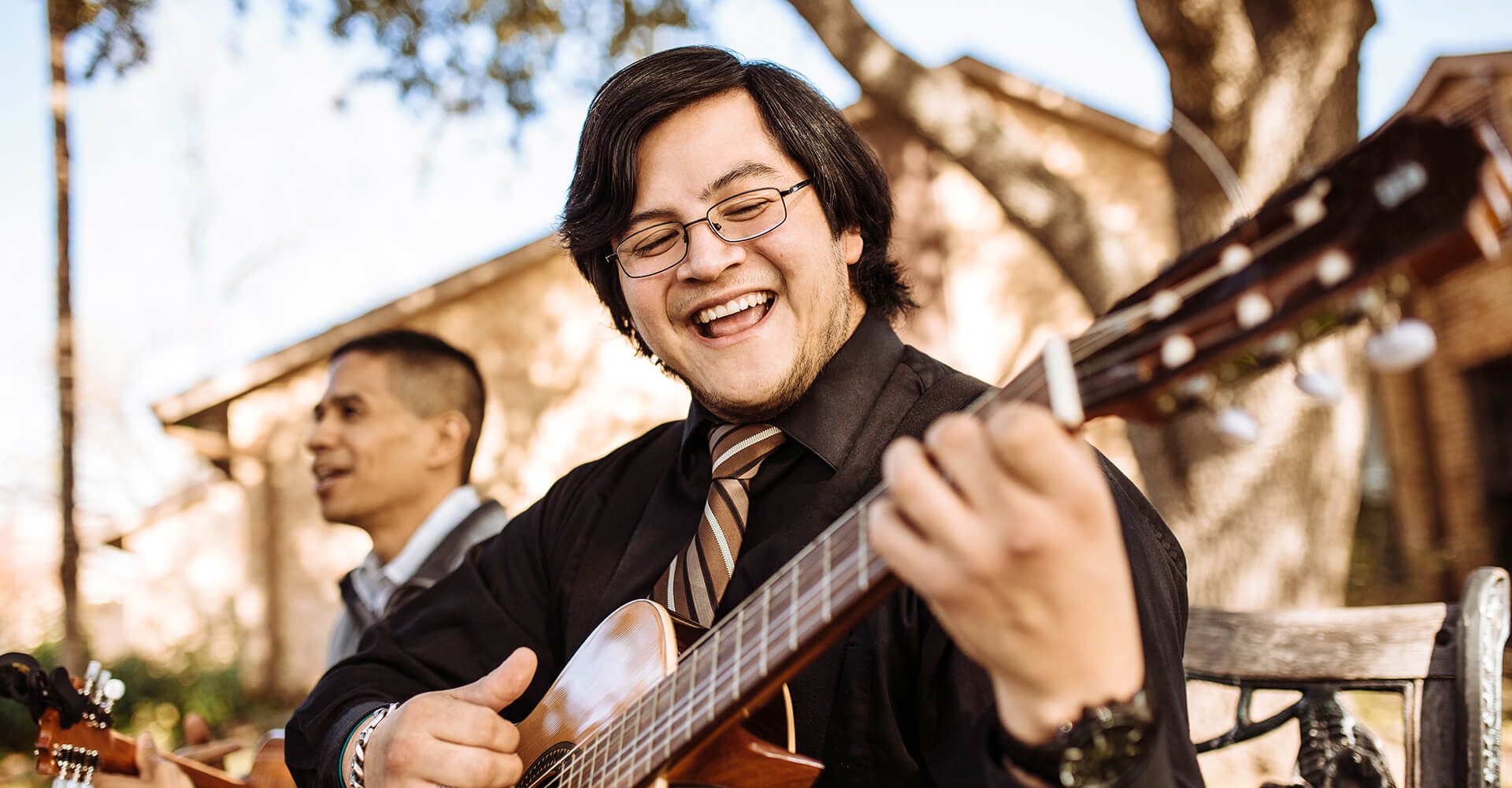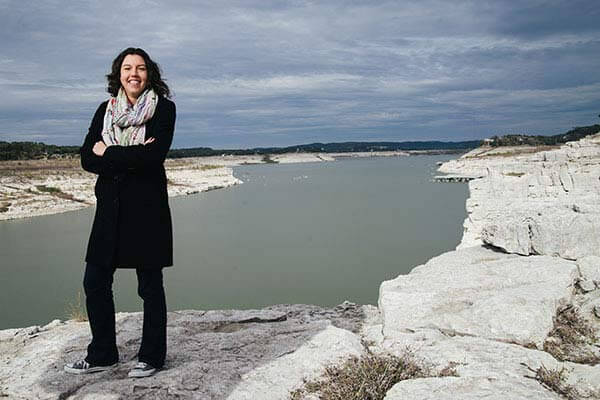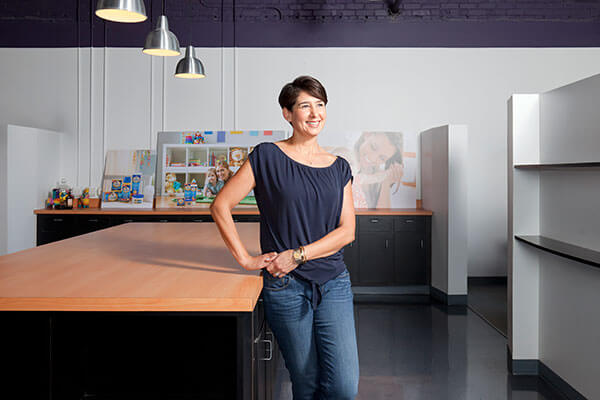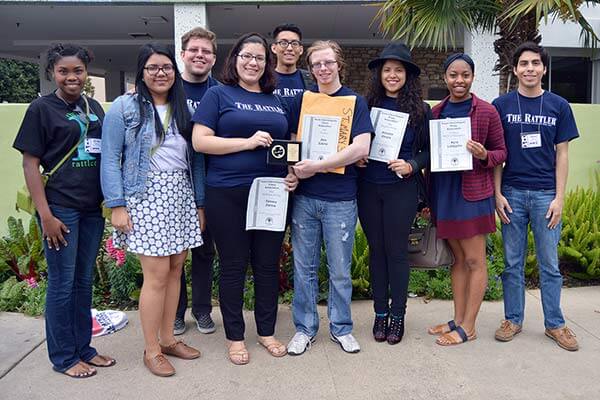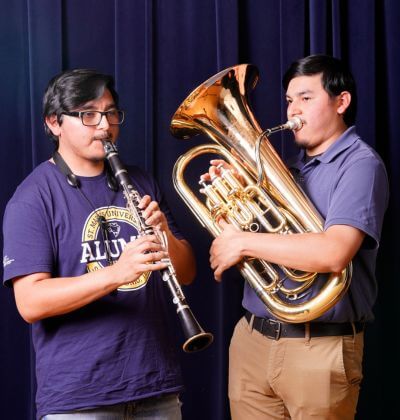by Alex Salinas (B.A. ’11)
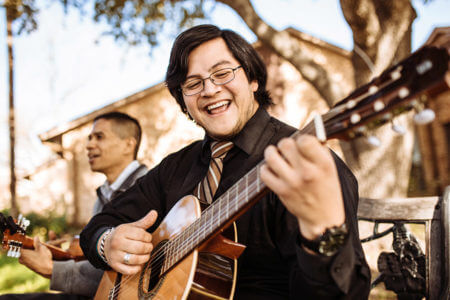
Trinidad Agosto (B.A. ’14) enjoying an afternoon of fellowship near Casa Maria.
The numbers are stark: The 313 Marianist brothers and priests in the United States have an average age of 74, and only about 25 of them are under age 50. About 20 die each year, and in the last decade, only five have taken final vows to become brothers.
Looking at the numbers, one might think the Society of Mary is fighting for its life.
So when two recent St. Mary’s University graduates, Justin Quiroz (B.A. ’13) and Trinidad Agosto (B.A. ’14), decided to undertake the lengthy process of becoming Marianists, one might also think the odds are stacked against them.
In truth, Quiroz and Agosto aren’t worried about the statistics. They are more concerned about taking things one day a time.
The Presence of God
Agosto, who lives in the Casa Maria community on the St. Mary’s campus, is a Marianist aspirant, which is the first stage to brotherhood in the Society of Mary. He is the only one in the nation.
All aspirants, once accepted into the Society of Mary’s formation program, live at Casa Maria for a year to see if they fit in. In this trial stage, aspirants attend Mass, prayer and outings with brothers, interacting with them and discovering if the Marianist lifestyle is a fit.
For Agosto, the journey to Casa Maria — let alone St. Mary’s — was improbable.
“Going to college wasn’t on my mind for most of high school,” the El Paso native said. “My parents didn’t go to college, but my dad was in the military, so that’s what I wanted to pursue.”
However, at 18 years old, Agosto started singing for fun with his then-girlfriend. After realizing he possessed a booming voice, his girlfriend encouraged him to seriously consider studying music.
“I Googled Texas colleges on a whim and wrote some down on a small list,” he said. “I narrowed the list to here and the University of Texas at Austin. I went to both of their sleeping bag weekends, but there was something about St. Mary’s where I felt an immediate connection.”
Majoring in vocal performance, Agosto took his mom’s advice of “putting your entire being into whatever you do” and ran with it, graduating on time.
Regretfully, Agosto also took that advice for his social life.
“Just like many college kids, I liked to party and have fun,” he said. “Alcohol became my vice that got me in trouble a few times, enough to where I lost some opportunities that came my way.”
It was the summer before his senior year, when he was in Ohio working an acting gig, that emotional turmoil got to him.
“I couldn’t sleep one night because so many thoughts were racing through my head and stressing me out that I started crying,” he said. “I was never too religious before, but I prayed and prayed. Suddenly, I felt a cooling sensation from the top of my head to my toes pass through my body.
“I was overcome with happiness; all my fears and doubts were put aside at the command of this inner voice that wasn’t mine,” he said. “In simplest terms, I felt the presence of God.”
Agosto said his brush with divinity — the most powerful sensation he ever experienced — affirmed his belief in God. When he got back to St. Mary’s, he was inspired to take action to re-create that feeling.
Before his last spring break as an undergraduate, which Agosto called the busiest week of his life, he participated in an event where he lived at Casa Maria to get a feel for Marianist way of life. He also learned about their history and asked questions about his faith.
“As busy and tired as I was, I had never been happier every day in a row,” he said.
Just months before graduation, Agosto didn’t know what a religious order was,
but after that week, he was ready to enter one.
One Step Closer
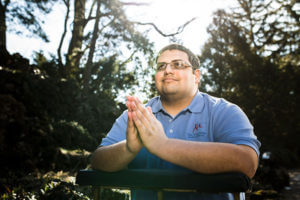
Justin Quiroz (B.A. ’13) is a Marianist novice living in Dayton, Ohio.
Quiroz, a Marianist novice living at the University of Dayton in Ohio, is one of four men in the two-year novitiate stage — the second step to becoming a professed brother.
In this phase, novices receive intensive instruction about their institution and the process of becoming a Marianist.
In many ways, Quiroz, a Houston native, was prepped for his religious journey before setting foot on the St. Mary’s campus.
“My older brother, first sister and I attended the same Catholic schools growing up, so Catholic education has been a large part of my life since early on,” he said. “When it came time to look at colleges, I was mainly focused on Catholic universities.”
While his older brother attended St. Edward’s University in Austin, Quiroz, like Agosto, went to the Internet for help.
“St. Mary’s came up, and I looked at it for a while and eventually applied,” he said. “Everyone I talked to at my high school, including teachers, hadn’t heard of the school before, so when I received an acceptance letter, I had to check it out.”
Sleeping Bag Weekend on campus was all Quiroz needed to fall in love.
“Throughout my sophomore year I was discerning another religious order, but it was during that year of being in the Marianist Leadership Program that Brother Mark Motz, who was an aspirant at the time, really introduced me to the Marianists,” Quiroz said.
Following a Society of Mary summer camp that connected Quiroz with brothers and priests across the country, his mind was made up. His close friends were supportive, but it was time to tell his family.
“When I told my family, the reaction was a little mixed because there was no one in our family of a religious profession, so there was this process of explaining to them the difference between a seminarian and someone in a religious order,” he said. “In the end, they were extremely considerate and understanding of my decision to enter.”
While Agosto’s spiritual calling came in college, Quiroz was exploring religious life before high school.
“I believe God has always been calling me to follow him more closely as a religious brother or priest,” he said. “It seemed odd to me not to explore this call. I did not want to let age disparity stop me from pursuing religious life, which I feel is often a discouraging issue for some.”
Generation Now
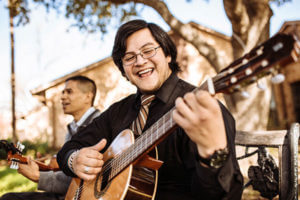
Agosto and Brother Dennis Bautista, S.M., Ph.D., play along on a sunny afternoon out side of Casa Maria.
Brother Dennis Bautista, S.M., Ph.D., Associate Professor of English and Communications Studies at St. Mary’s, knows well the challenges that secular life presents to young people considering walking away from it.
“Becoming a priest or anything similar today is generally not regarded as a promising, prestigious or normal thing to do,” he said. “It’s not a widely discussed option in our families and in our classrooms.”
Bautista had already earned a doctorate; worked his dream job teaching communications at his undergraduate alma mater, Chaminade University; and had a girlfriend before he professed perpetual vows, the last step to becoming a Marianist, in 2009.
“I wanted faith to be the most important part of my life, more than just one Sunday a week, but it wasn’t until I earned my Ph.D. that I began to put more time into it,” the native Hawaiian said. “I told my girlfriend I was thinking about becoming a Marianist and — after some silence — she responded, ‘I can see you doing that.’ That gave me the green light to go and do it.”
Bautista said that living and working away from home as well as having a long-distance relationship gave him time to reflect on his faith and learn more about himself.
Arriving at Casa Maria as a 30-year-old aspirant in 2003, he became a Marianist brother six years later. At the ripe age of 41, Bautista is still a young gun among his peers and considers himself the “Generation Now” of Marianists.
In addition to teaching and advising the student newspaper, he is responsible for every aspirant in the U.S. as the Society of Mary Aspirancy Program director, an elected position he’s held for three years.
“What I do now prepares the future of the Marianists,” he said. “It’s my job to provide a healthy living environment and good foundation to being a good Catholic for those who step through our doors.”
Bautista said it takes at least six years to “build” a brother — from aspirancy to novitiate to temporary vows to perpetual
vows. Even then, daily issues don’t go away for full brothers.
“Just like marrying another person, we marry God, so we must rededicate ourselves every day to the mission, which is to bring the story of Jesus Christ to the world through Mary, his mother.”
Using Mary as a model of faith, Marianist brothers profess four vows: poverty, chastity, obedience and stability.
Bautista understands the conflicts that not only affect young men, but older ones too.
“What happens if a brother becomes depressed, abusive, alcoholic or falls in love with someone?” he said. “There are so many situations that we have to be ready to handle, and it all starts with creating a loving and supportive foundation.”
Quality, Not Quantity
When it comes to the numbers game, Father Martin Solma, S.M., Society of Mary Provincial for the U.S. and St. Mary’s University Chancellor, isn’t alarmed. Instead, he’s realistic.
“Our membership has declined the last two decades, but we’ve always been relatively small,” he said. “The natural temptation is to lower our standards during the application process, but then there will be problems later on. If anything, we’ve raised our standards.
“We look for good, quality men.”
Solma said World War II and the rise of the Baby Boomers directly impacted the current makeup of U.S. Marianists.
“The resurgence of members in the 1950s was an anomaly,” he said. “The overall population increased, as did we.”
While Marianists are spread across four continents and 40 countries, especially in Africa and India where communities are “growing leaps and bounds, with the average age of an Indian brother at 38 years old,” the priority has always been to educate and develop spiritual leaders, Solma said.
“Most people understand priesthood, but not brotherhood,” he said. “Brothers aren’t half-priests or people who’ve gone 50 percent of the way; they’ve taken vows and given their lives to Christ. The beauty is they can be teachers, ministers or plumbers if they want.”
Solma, an ordained Marianist who leads the U.S. province, said both brothers and priests can lead provinces, according to how the Society of Mary founder, The Blessed William Joseph Chaminade, structured it.
“Father Chaminade came out of the French Revolution where ideas of freedom and liberty were born,” he added. “The unique thing about him was he formed lay communities first, then the Daughters of Mary Immaculate together with the Venerable Adèle de Batz de Trenquelléon in 1816, and finally the Society of Mary in 1817.”
While Marianists are flourishing internationally, Solma isn’t panicked about their dwindling numbers in the U.S.
“We’re likely to be smaller in the future, of course,” he said. “This way of life is not for everybody. Choosing to live a celibate life to promote the word of God is a huge deal.”
Solma acknowledged societal norms have changed.
“When I was a novice in the 1970s, there were 40 guys in formation with me,” he said. “I believe young people today are faced with commitment issues more than past generations, but at the same time, those who joined the Marianists back then were typically fresh out of high school.
“Aspirants now are typically a bit older and college educated.”
There aren’t as many young men joining the order as when he did, but those now are more intentional about their decision because they are equipped with more life experience, Solma said.
Reason and Hope
Agosto and Quiroz still think about what a different path would have led to.
“Living in a religious community with people of different ages and backgrounds is a radical transition from what I was used to,” Quiroz said. “There are thoughts that cross my mind about experiences or things I haven’t done. That’s a challenge of being young.”
One of those experiences is the biological kind: being a father.
“I would love to be one of those cheesy dads, but I remind myself I’m where I’m at because of God,” Agosto said. “This is a serious life journey that requires me to be level-headed, mature and willing to make sacrifices.”
Despite their doubts, both men have a path set and plans for their future.
Quiroz wants to teach at a Marianist high school, and Agosto, who is currently an assistant choir director at Central Catholic High School, would like to use his vocal cords as a professional performer.
As for the future of the organization they signed up for?
“Given the average age of Marianists in the U.S., I don’t know how many of them we can expect on the grounds of our 18 high schools, three universities, seven parishes and four retreat centers in 10 years,” Bautista said, “but if we made joining a religious order a valid option for young people in our classrooms and in the community — young people who probably have big questions about their faith — we can inspire hope and change our outlook for the better.
“After all, we’re still here, so God has already given us reason and hope.”

